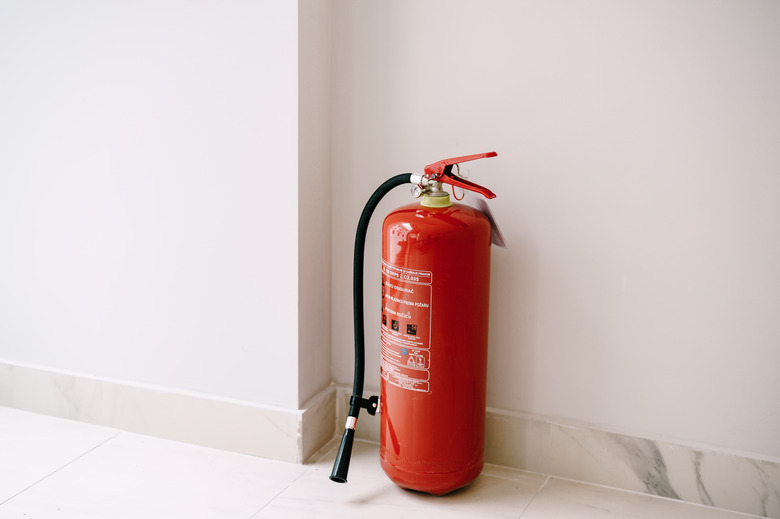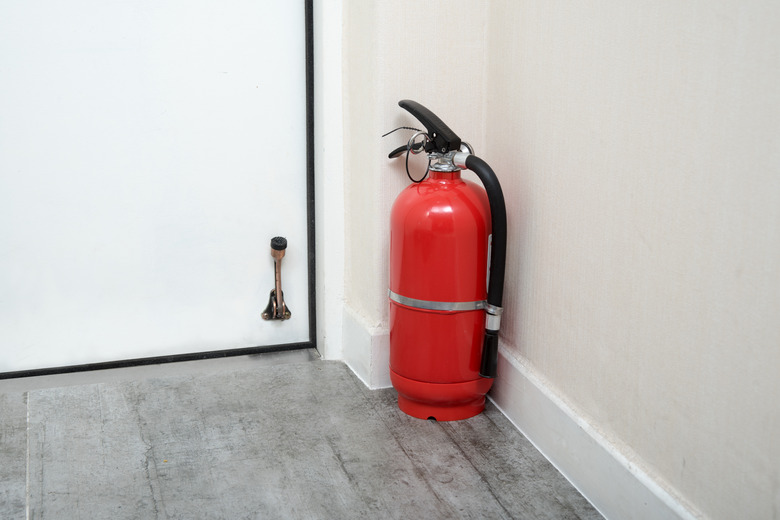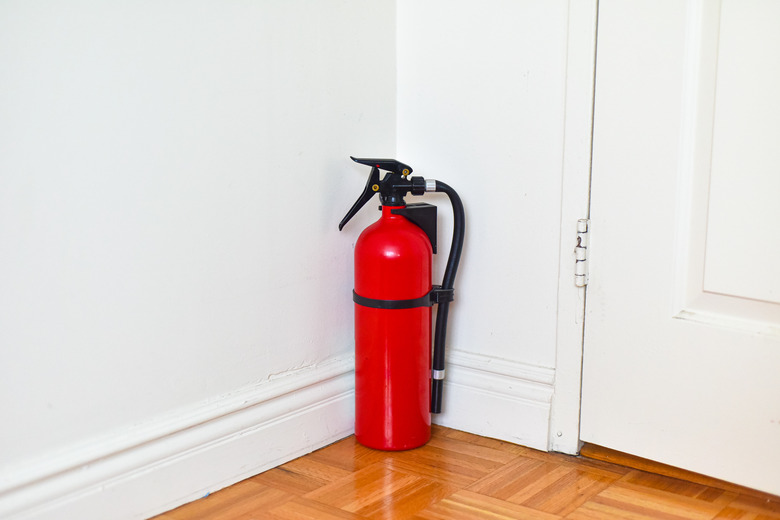The Complete Fire Extinguisher Buying Guide
We may receive a commission on purchases made from links.
Having a fire extinguisher in your home can help save lives and is one of the best home safety tools that you can buy. According to the National Fire Protection Association (NFPA), home fires in the United States resulted in over 2,600 deaths and over 11,000 injuries between 2014 and 2018, and the leading cause of home fires is cooking. A small kitchen fire is one of the best examples of a fire that can safely be put out with a home fire extinguisher.
To extinguish any small fire safely, you need to have the right type of fire extinguisher and have it accessible when you need it. You also need to know how to use the extinguisher properly, including knowing when a fire is small enough to manage yourself.
Fire Extinguisher Classes
Fire Extinguisher Classes
When shopping for a fire extinguisher, you'll be confronted with some ratings symbols that refer to the extinguisher's class and size or capacity. The class of fire extinguisher indicates the type of fire it is designed to put out:
- A: Class A extinguishers can put out solid combustibles, such as paper, wood, cloth and various plastics.
- B: Class B extinguishers can put out flammable liquids, including gasoline and oil.
- C: Class C extinguishers can put out fires on energized electrical equipment, such as appliances or wiring.
- K: Class K extinguishers are best suited for putting out cooking-related fires involving cooking oils, such as animal and vegetable fats. These are typically used in commercial kitchens.
There's also a fifth class, Class D, which is designed for putting out fires on flammable metals. These types of fire extinguishers are found in factories and other industrial environments and are not designed for home use.
While it's helpful to know what the class letters mean when you see them, the decision of which class to get is simple: Almost all fire extinguishers sold for home use are ABC, so they are suitable for multi-purpose fire extinguishers that can handle almost any fire that could occur in a home.
Fire Extinguisher Sizing
Fire Extinguisher Sizing
Sizing or capacity ratings are a bit more complicated than class designation. These are indicated by numbers, and they are associated with a different classing system that does not directly relate to Class A, B, C or K. In any case, since you're getting an ABC fire extinguisher, you don't need to worry about the letters in the capacity rating.
The capacity rating includes two numbers. The first is the equivalence to gallons of water; the second is square feet of coverage. The most common rating for home extinguishers is 3A:40-B:C.
- The 3 indicates the extinguisher is equivalent to 3.75 gallons of water (1A is equivalent to 1.25 gallons).
- The 40 indicates a coverage area of 40 square feet, meaning it can put out 40 square feet of flames. However, this rating is based on optimal use of the extinguisher; in reality, the coverage will likely be less than the rated area.
As the capacity ratings go up, so do the physical size and weight of the extinguisher. A high-capacity extinguisher has more stuff inside to put out more fire, but it's also bigger and heavier than a smaller unit with lower capacity ratings.
Best All-Around Extinguisher for Homeowners
Best All-Around Extinguisher for Homeowners
It's always a good idea to have more than one fire extinguisher in the home, but if you have only one, you want something that has good capacity but is also small enough for easy handling and storage. Therefore, the most commonly recommended home fire extinguisher is Class ABC with a capacity rating of 3A:40-B:C. This general-purpose extinguisher weighs about 8 to 9 pounds and stands about 18 inches tall. It typically comes with a mounting bracket for hanging it on a wall or inside a cabinet.
All homes should have at least one heavy-duty, general-purpose extinguisher. If you want more extinguishers, you might choose a different type and/or size for specific locations. For example, there are compact kitchen fire extinguishers that are commonly rated 5B:C. These are optimized for cooking and grease fires, and they're small enough to stash in any kitchen cupboard.
Tips for Using a Fire Extinguisher
Tips for Using a Fire Extinguisher
A fire extinguisher is the right tool for putting out a fire if:
- The fire is small and confined, like on the stove top or in a garbage can.
- It's not getting any bigger.
- The room isn't filled with smoke.
If there's a fire, the priority should be getting everyone outside safely. Make sure to call the fire department.
You're not likely to get much practice with a fire extinguisher, so it can be easy to forget how to use one. A helpful acronym for remembering the steps involved in discharging a fire extinguisher is "PASS." The steps include:
- Pulling the pin, making sure to point the nozzle head away from your face and body.
- Aiming low, pointing toward the base of the fire and not the top.
- Squeezing the lever, making sure to do so slowly and evenly.
- Sweeping the nozzle, moving the extinguisher from side to side.
Keep your fire extinguisher close to an exit and make sure there's an exit behind you when discharging the device. That way, you have a clear path should the fire get out of control.
Where to Store a Fire Extinguisher
Where to Store a Fire Extinguisher
You should have an extinguisher on each level of your home, and your extinguisher should be in a spot that's readily accessible. (Shoving it in the back of an out-of-reach ceiling-height cabinet is a bad idea.) Most fire extinguishers come with hardware for mounting, and mounting your fire extinguisher ensures that it's easily accessible and within view. Mounting also helps prevent accidental damage to the unit.
Keep your fire extinguisher in a spot where it won't be exposed to high temperatures, which often means keeping it several feet away from potential heat sources, like an electric space heater or a stove. Although high temperatures may not damage the device, they can slow down discharge. You should also keep it away from freezing temperatures since these can cause parts of the unit to crack.
Fire Extinguisher Maintenance
Fire Extinguisher Maintenance
Having an extinguisher in your home is useless if you don't maintain it properly. To keep your fire extinguisher in working condition, you should check the pressure gauge once in a while to ensure that the needle is in the green zone. Beyond that, maintenance of your fire extinguisher should also include accessibility checks. Is your fire extinguisher still within reach? Is there anything blocking the way if you need to grab it readily? If necessary, take the time to remedy any issues. The last thing you want is to be digging for your fire extinguisher during an emergency.
If you have a rechargeable fire extinguisher, many fire departments are able to help you recharge your device, but of course, you should throw away a disposable extinguisher if it has been discharged. If you're unsure about inspecting the unit yourself, contact a professional to inspect your extinguisher, and they will inform you if you need a new one.
If you suspect that your fire extinguisher is beyond maintenance, it's best to just get rid of it. Replace your fire extinguisher if there are any signs of damage, including dents or rust, if the pressure gauge needle is in the red or if you used it to put out a fire.
Keep in mind that fire safety involves more than just having a fire extinguisher on hand. Ensure your home is equipped with working smoke alarms and that you have an emergency plan in place.
References
- National Fire Protection Association: Fire Extinguishers
- Kidde: Fire Extinguishers for Home
- St. Lawrence University: Fire Extinguisher Frequently Asked Questions (Information from Lab Safety Supply)
- U.S. Fire Administration: Choosing and Using Fire Extinguishers
- UC San Diego: Fire Extinguisher Inspection Checklist
- University of Rochester Medical Center: Do I Really Need a Fire Extinguisher?
- Bettendorf Fire Rescue: All You Ever Wanted to Know About Fire Extinguishers
- Kidde: Fire Extinguishers


